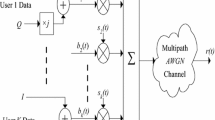Abstract
In this paper a multicarrier CDMA (MC-CDMA) system with a soft decision differential phase shift keying (DPSK) frequency domain RAKE receiver is described. We compare a MC-CDMA system with a direct sequence CDMA system using RAKE receivers. In contrast with previous MC-CDMA systems, guard intervals are not used and the carriers are spaced at the reciprocal of the bit rate, optimising the usage of the bandwidth. In this way a comparison can be made between the multicarrier CDMA system described and a direct sequence (DS-CDMA) system with the same bandwidth. The results presented are received bit error rates from Monte Carlo simulations. The simulations are conducted in a multipath channel with Rayleigh fading and 300 Hz Doppler spectrum with additive white Gaussian noise. It is shown that the multicarrier CDMA matched filter receiver performs favourably compared to the direct sequence CDMA matched filter receiver for 1 -path fading. For a single user at a receive bit error rate of 1×10−3 in the 4-path fading channel the multicarrier RAKE receiver requires no knowledge of the channel delay spread and performs 3 dB worse than the DS-CDMA RAKE receiver simulated. The performance of the MC-CDMA RAKE receiver for a single user increases with increasing channel dispersion. The performance of the DS-CDMA RAKE receiver for multiple user is superior to that of the MC-CDMA RAKE receiver.
Similar content being viewed by others
References
L. Cimini, “Analysis and simulations of a digital mobile channel using orthogonal frequency division multiplexing,” IEEE Trans. Commun., Vol. COM-33, pp. 665–675, 1985.
C. Reiners and H. Rohling, “Multicarrier/transmission technique in cellular mobile communications systems,” Proceedings IEEE VTC'94, pp. 1645–1649, 1994.
M. Alard and R. Lasselle, “Principles of modulation and channel coding for digital broadcasting for mobile receivers,” EBU Review, pp. 168–190, 1987.
A. Chouldy, A. Brajal, and S. Jourdan, “Orthogonal multicarrier techniques applied to direct sequence spread spectrum CDMA systems,” IEEE Globecom 93, Vol. 3, pp. 1723–1728, 1993.
K. Fazel, “Narrow-band interference rejection in orthogonal multi-carrier spread-spectrum communications,” IEEE Int. Conference on Universal Personal Communications, pp. 46–50, 1994.
K. Fazel, “Performance of CDMA/OFDM for mobile communications,” IEEE Int. Conference on Universal Personal Communications, pp. 975–979, 1993.
K. Fazel, “Performance of convolutional coded CDMA/OFDM in a frequency-time selective fading Channel and its near-far resistance,” IEEE Int. Conference on Communications (ICC), New Orleans, USA, pp. 1438– 1442, 1994.
N. Yee, J. Linnartz, and G. Fettweiss, “Multi-carrier CDMA in indoor wireless radio networks,” IEICE Trans. Commun., Vol. E77-B, pp. 900–904, 1994.
G. Turin, “The effects of multipath and fading on the performance of direct sequence CDMA systems,” IEEE Journal Sel. Areas Commun., Vol. SAC-2, pp. 597–603, 1984.
G. Fettweiss, A. Bahnai, and K. Anvari, “On multi-carrier code division multiple access (MC-CDMA) modem design,” Proceedings IEEE VTC'94, pp. 1670–1674, 1994.
J. Proakis, Digital Communications. New York: McGraw-Hill, 2nd ed., 1983.
G. Povey, P. Grant, and R. Pringle, “A decision-directed spread spectrum rake receiver for fast fading mobile channels,” Proceedings IEEE VTC'94, pp. 742–746, 1994.
M. Failli, ed., Digital Land Mobile Radio Communications — COST 207: Final Report. Luxembourg: Commission of the European Communities, 1989.
Author information
Authors and Affiliations
Rights and permissions
About this article
Cite this article
Stirling-Gallacher, R.A., Povey, G.J.R. Comparison of MC-CDMA with DS-CDMA using frequency domain and time domain RAKE receivers. Wireless Pers Commun 2, 105–119 (1995). https://doi.org/10.1007/BF01099533
Issue Date:
DOI: https://doi.org/10.1007/BF01099533




